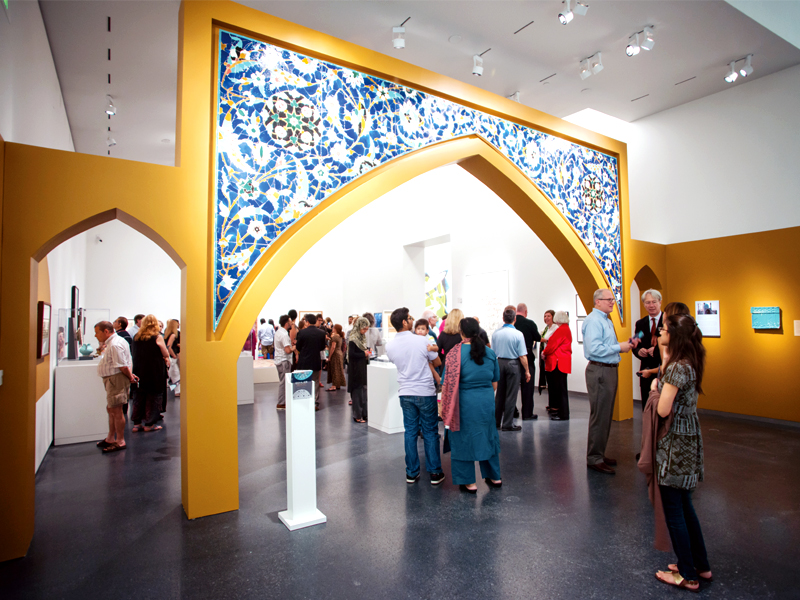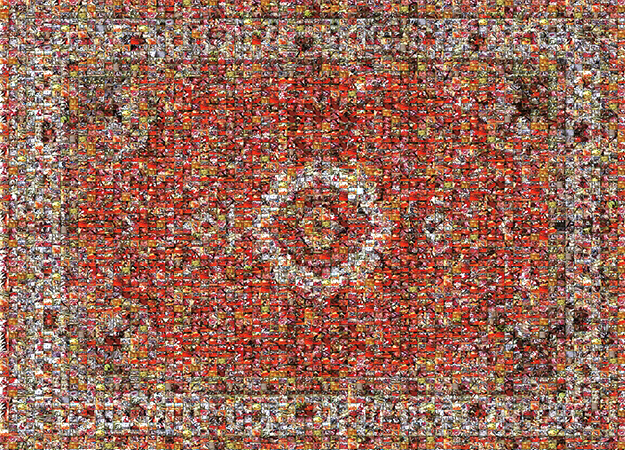
As visitors approach the museum, they first encounter American artist Asheer Akram’s 1950s Chevrolet grain truck, an all-American symbol that has been given a Pakistani truck art makeover with bold enamel-coated Islamic geometric patterns, curvilinear metal-work and even a bison on the back. The different elements work well together to give the sense of truck art without replicating it slavishly. For example, the bison, indigenous to the Great Plains of the central US where Akram was born and raised, could very well have been from a Pakistani landscape.

(Left) Bowl, Iran, late 12th-early 13th century. Persian, Iran, Seljuk Dynasty (1038-1250s). Fritware with opaque turquoise glaze and over-painted decoration. PHOTO: NAMA
(Right) Hamra Abbas, Pakistani, b 1976. Paper Plates, 2008. Paper collage. PHOTO: NAMA
And so the ornamentation of an American truck works the theme of the exhibition whose central message seems to be that there can be no breaking away from tradition — mainly because culture echoes in the contemporary.
Visitors are primed for their visual experience by walking under one of the museum’s earliest Islamic treasures, a 17th-century Persian mosaic arch, which serves as the entrance to the gallery. The idea was to evoke the experience of walking under one of these grand, ornate iwans in Iran. The arch has been displayed for the first time in over three decades.

(Above) Rashid Rana, Pakistani, b 1968. Red Carpet 3, 2007. Chromogenic print and Diasec mounted. PHOTO: MYARTTRACKER.COM
Curator Masteller has thus brought together the old and the new in 28 works from Islamic cultures across the globe, some of which date to the 9th Century. The Pakistanis taking part include Shahzia Sikander, Ayesha Jatoi and Rashid Rana. The media are wide-ranging from ceramics and textiles to decorative brass and video art.
While the objects span centuries and continents, they are brought together in this exhibition because of the shared visual characteristics. “Many contemporary artists are using the visual language of Islamic art and transforming it in their own work,” says Masteller. This is especially evident in the contemporary miniature painting movement in Pakistan, a revival of the techniques of traditional Mughal painting. The seminal figure of this movement is Professor Bashir Ahmed who taught it at the National College of Arts. Masteller explains that the success of two of his early students, internationally acclaimed artist Shahzia Sikander and Imran Qureshi, turned miniature paintings into a new genre. “These paintings reveal a clear connection to the Mughal tradition and are also at home in a contemporary gallery,” says Masteller. The exhibition includes a painting by Bashir Ahmed and a video by Sikander, ‘The Last Post,’ that animates a series of her miniature paintings among a handful of other works.

(Left) Salim Qulli, Indian, act ca 1590-1605. Attributed to: Lal, Inidan, act ca 1590-1605. Leaf from the Muraqqa Gulshan: The Poet and the Prince (recto) Calligraphy (verso), ca 1595-1597. Indian, Agra or Allahabad, India, Mughal Dynasty (1526-1857). Watercolour and gold paint on paper. PURCHASE: WILLIAM ROCKHILL NELSON TRUST, 48-12/1 A,B
(Right) Shahzia Sikander, Pakistani, b 1969. The Last Post, 2010, detail. HD video animation with Surround Sound 5.1. PHOTO: ARTIST
“Pakistani contemporary art is more than only miniature painting, however, and we have included works by Rashid Rana and Hamra Abbas that use modernist strategies and conceptual approaches to photography and objects to create meaning,” adds Masteller. “Rashid Rana’s powerful ‘Red Carpet 3’ and Hamra Abbas’s seemingly mundane ‘Paper Plates’ are particularly striking.”
Rashid Rana’s ‘Red Carpet 3’ looks like a traditional carpet but is actually a photomontage of scenes from slaughterhouses in Lahore. Rana, who is one of the top artists on the global scene today, creates prints, sculptures and installations using photo mosaics. His famed Red Carpet series examines violence and our desensitization to it. He chose to photograph slaughterhouses in his hometown because as a child he found the slaughtering of animals disturbing. “He then digitally wove the images from the hundreds he has taken into a large image, which is based upon a Persian medallion carpet,” explained Masteller. “Rana said that he chose this subject for its Orientalist reading, as a kind of sign of ‘The East’.” The photoshoot for the series coincided with the return from self-exile of Benazir Bhutto, former prime minister of Pakistan, and the attack on her homecoming parade, imbuing this series with a larger and more powerful context given the ‘sacrifice and slaughter’ of innocent lives in Pakistan.

(Left) Hayv Kahraman, Iraqi, b 1981, lives and works in Oakland, California. Icosahedral Body, 2013. Wood and aluminium. PHOTO: ARTIST AND JACK SHAINMAN GALLERY, NY
(Right) Nasser Al-Salem, Saudi Arabian, b 1984, lives and works in Jeddah, Saudi Arabia. “And Whoever Obeys Allah — He Will Make For Him A Way Out,” 2013. Corian sculpture. PHOTO: ATHR GALLERY
In somewhat comparable fashion, Hamra Abbas also shuttles between the micro and macro to make us do a double-take on an object. Her paper plate at first looks like filigreed lace-work set in the eight-pointed star arabesque design. She created them with strips of paper on a leaf plate press, to make replicas of disposable paper plates. “An ordinary paper plate is well known among disposable items,” she says. “And I use its literalness as a disposable commodity to create an ornate paper plate that is anything but useable.” If you look closer, on each paper strip forming the plate you will see the printed words “please get served” to reference the real function of a paper plate and a pun on its real function, for this plate cannot be served in.
Not all the art is ‘clever’ like this, for a lack of a better word. Sometimes, a visual representation of text creates rich new symbolism. So, for example, Saudi Arabian artist and calligrapher Nasser Al-Salem was inspired by a verse from the Qur’an, “And Whoever Obeys Allah — He Will Make For Him A Way Out” which he translated into a blue maze made of the acrylic material corian. He explains it by saying: “Although you could say my work is very much inspired by my religion, I by no means have a specific audience, and hope that my messages have a spiritual or historical significance for everyone.” That is exactly what the museum hopes this exhibition will achieve.
Published in The Express Tribune, Sunday Magazine, September 29th, 2013.











1736508423-0/Express-Tribune---News-Desk-(9)1736508423-0-270x192.webp)


1736495887-0/sidra--(63)1736495887-0-270x192.webp)








COMMENTS
Comments are moderated and generally will be posted if they are on-topic and not abusive.
For more information, please see our Comments FAQ